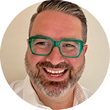- OT
- Life in practice
- Business management
- Create a welcoming environment for every patient?
How do I…
Create a welcoming environment for every patient?
Optometrist and coach, Peter Greedy, outlines the questions you should ask yourself in order to create a welcoming practice environment

06 February 2023
Being a healthcare professional is such a privilege. We optimise people’s vision, ensure their eyes are healthy, and help them choose appropriate vision correction options. All of this is an important contribution to their lifestyle and wellbeing.
When we meet a patient for an appointment, what do we see? What thoughts go through our mind? How does what we see and hear (and sometimes smell) influence our thought process, and how we relate to and subsequently treat that person? Do we take an interest in the person sat in front of us, or do we plough through the appointment, conscious of the time, conversion rate, and other KPIs?
Every person I’ve met has a story, and their stories are always interesting
How we welcome clients determines their first impression of us, and how we continue to communicate with them will determine the ongoing relationship we establish that could last a lifetime. So, it is important to invest some thought and development into this aspect of our professional healthcare provider role. Here are some key considerations.
First impressions
Some of this did not come naturally to me. I have a highly-tuned sense of smell, and there have been times when I have felt nauseous from potent odours of stale nicotine, body odours, and worse. In the past these have generated biased stereotypes, which I would now be ashamed of. The person in front of me is a human being just like me and, time and again, when I get curious and compassionate about their story, those biases and judgements disappear in tales of struggles, hardship, illness, suffering, and sometimes just a different life story to mine.When you come across such a situation in practice, it is important to ask yourself: what story do I make up? What biases do I hold (remember that the biggest bias is, ‘I am not biased’)? What judgments do I make?
The assumption of positive intent
This is choosing to believe that people are doing their best, at that moment in time, in the circumstances in which they find themselves.
Here’s a personal example. For years I had a poor attitude towards homeless people. I would avoid their gaze, and never stop to engage or give them money. This has changed dramatically as I have worked on my attitude and become more attuned to the life privileges I have. It sounds silly to have to state this, but I’ve grown to understand that we are all human beings, all equal, and my previous behaviour and attitude was dehumanising and unacceptable. What right do I have to judge someone else for addiction or mental health issues, or situations that I know nothing about?
I encourage us all to take a moment to reflect on how we can better relate to those we are privileged to meet and serve in our work
I could not imagine being in the position of being homeless, so who am I to judge what a homeless person might spend my spare change on? Now, when I pass a person sleeping rough, I make a point of looking them in the eye and greeting them. I may give them money, or I may buy them a coffee and sandwich. But I treat them as an equal, as that is what they are. It is vital that we take this attitude into our consultation rooms.
My personal ‘why’ statement is ‘to champion courageous, curious, compassionate conversations, so that people connect wholeheartedly.’ I am always pleasantly surprised when I do this in an eye exam. It’s a safe space to engage with people, and almost everyone I get curious with has something interesting to tell me. We find common interests or connections, and it transforms the experience for both the client and for me. I encourage us all to take a moment to reflect on how we can better relate to those we are privileged to meet and serve in our work.
Peter Greedy is an optometrist, leadership consultant and coach. He can be contacted on 07906632378, or via his website.


Comments (0)
You must be logged in to join the discussion. Log in